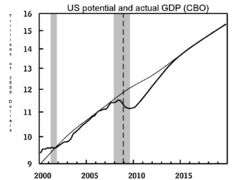
Back Produktionslücke German Brecha de producción Spanish Écart de production French Kibocsátási rés Hungarian Output gap Italian 産出量ギャップ Japanese 아웃풋 갭 Korean Izlaides starpība Latvian/Lettish Produksjonsgap NB Luka PKB Polish



The GDP gap or the output gap is the difference between actual GDP or actual output and potential GDP, in an attempt to identify the current economic position over the business cycle. The measure of output gap is largely used in macroeconomic policy (in particular in the context of EU fiscal rules compliance). The GDP gap is a highly criticized notion, in particular due to the fact that the potential GDP is not an observable variable, it is instead often derived from past GDP data, which could lead to systemic downward biases.[3][4][5][6]
- ^ 100*(Real Gross Domestic Product-Real Potential Gross Domestic Product)/Real Potential Gross Domestic Product | FRED | St. Louis Fed
- ^ Real Potential Gross Domestic Product, Real Gross Domestic Product | FRED | St. Louis Fed
- ^ Barkema, Jelle; Gudmundsson, Tryggvi; Mrkaic, Mico (2020-12-06). "Output gaps in practice: Proceed with caution". VoxEU.org. Retrieved 2020-12-06.
- ^ ""Output Gap Nonsense" and the EU's Fiscal Rules". Institute for New Economic Thinking. Retrieved 2020-12-06.
- ^ "True, the output gap is an elusive concept that should never have become a gauge for conducting public policy, and it may be larger than thought.", Monetary policy: lifting the veil of effectivenes, Speech by Benoit Cœuré, 18 December 2019
- ^ Orphanides, Athanasios and Simon van Norden (2002) '"The unreliability of output gap estimates in real time"', Review of Economics and Statistics, 84(4), November 2002, pp. 569–583